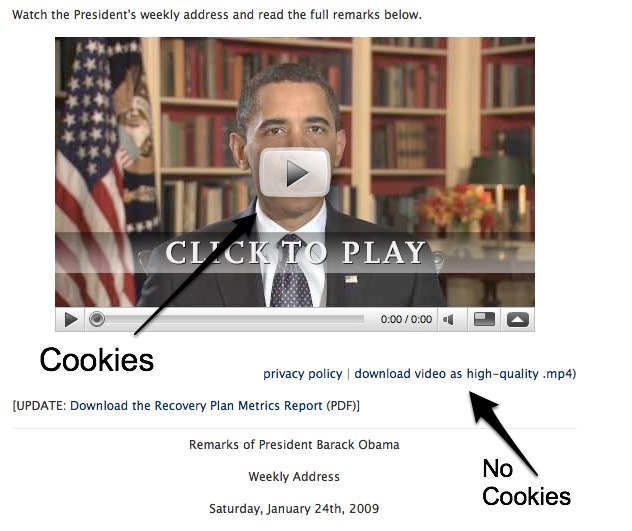Whitehouse.gov's YouTube cookies: The wrong privacy fight

I'm the last person who would ever want the government snooping around my computer. But this controversial thing over YouTube cookies on whitehouse.gov has really become bigger than it should be and I think privacy advocates - no matter how much I agree with them on the larger scale issues - may be fighting the wrong fight here.
For those catching up, the White House has issued an exemption to the no-cookies rule on whitehouse.gov. The rule, of course, allowed visitors to freely visit the site without any identifiable information being left behind on the government's site. But Google-owned YouTube, which hosts President Obama's weekly video address, is being granted an third-party exemption from the policy so it can "help maintain the integrity of video statistics."
It's also important to note that the cookie only installs if the user clicks on the embedded video to watch. (see image below) If you don't want a cookie installed, the you can download it to your computer and still maintain your privacy. This is the only place where the cookie issue comes into play.
Privacy advocates are holding President Obama's administration to its promise for a more open and transparent government - as they should - by calling on the administration to provide a copy of the waiver referenced in the new policy. This stemmed from a language change in the policy a few days ago that took out references to YouTube and instead used "third-party providers." Chris Soghoian, who writes CNET's Surveillance State blog, writes:
...the White House has yet to actually provide a copy of the waiver (something this blogger has requested from White House officials informally, as well as via the Freedom of Information Act). The text of the original privacy policy implied that a specific waiver had been issued for the cookies forced upon end users who intentionally viewed YouTube videos embedded within the White House Web site. The text now implies a far broader waiver for multiple video-sharing Web sites. However, it remains unclear if a new waiver has been issued, or if the old waiver was broad enough to cover multiple sites.
My two cents:
- First, the White House ought to just cough up the waiver and be done with it. It's just a policy waiver related to videos on a Web site. It shouldn't be a big deal. Repeat after me: Open and Transparent.
- Second, the issue of the cookies exemption has already been addressed - and isn't that the bigger issue here? There's a go-around. Just download the video and watch it offline if that makes you feel safer.
- Third, if privacy advocates want whitehouse.gov to do more, shift the focus to calling for a redesign of the page, specifically how the "Click to Play" is displayed, compared to the "download video" link. Make sure visitors know that cookies are involved when you Click to Play and give them the option to download instead (and then be able to stop future warnings.)
It's also important to note that the whole YouTube video thing is part of President Obama's attempt at a more open and transparent government. Look at how many tech-savvy people were caught up in the campaign because of Web 2.0 tools like Facebook, MySpace, Twitter and YouTube. The president could have chosen to walk away from the online world after he won and gone back to the old-school radio address. But wouldn't we rather have his weekly update accessible around the clock, on a site where millions of people already go to watch videos.
As an after-thought, I'm feeling reassured that someone in Washington knew enough about embedded video technology and the language of the privacy policy to make changes. There have been a lot of technology changes - and new issues surrounding privacy - since the original one was put in place in 2000.
Has it been updated regularly? Maybe it's time for Privacy Policy 2.0.
